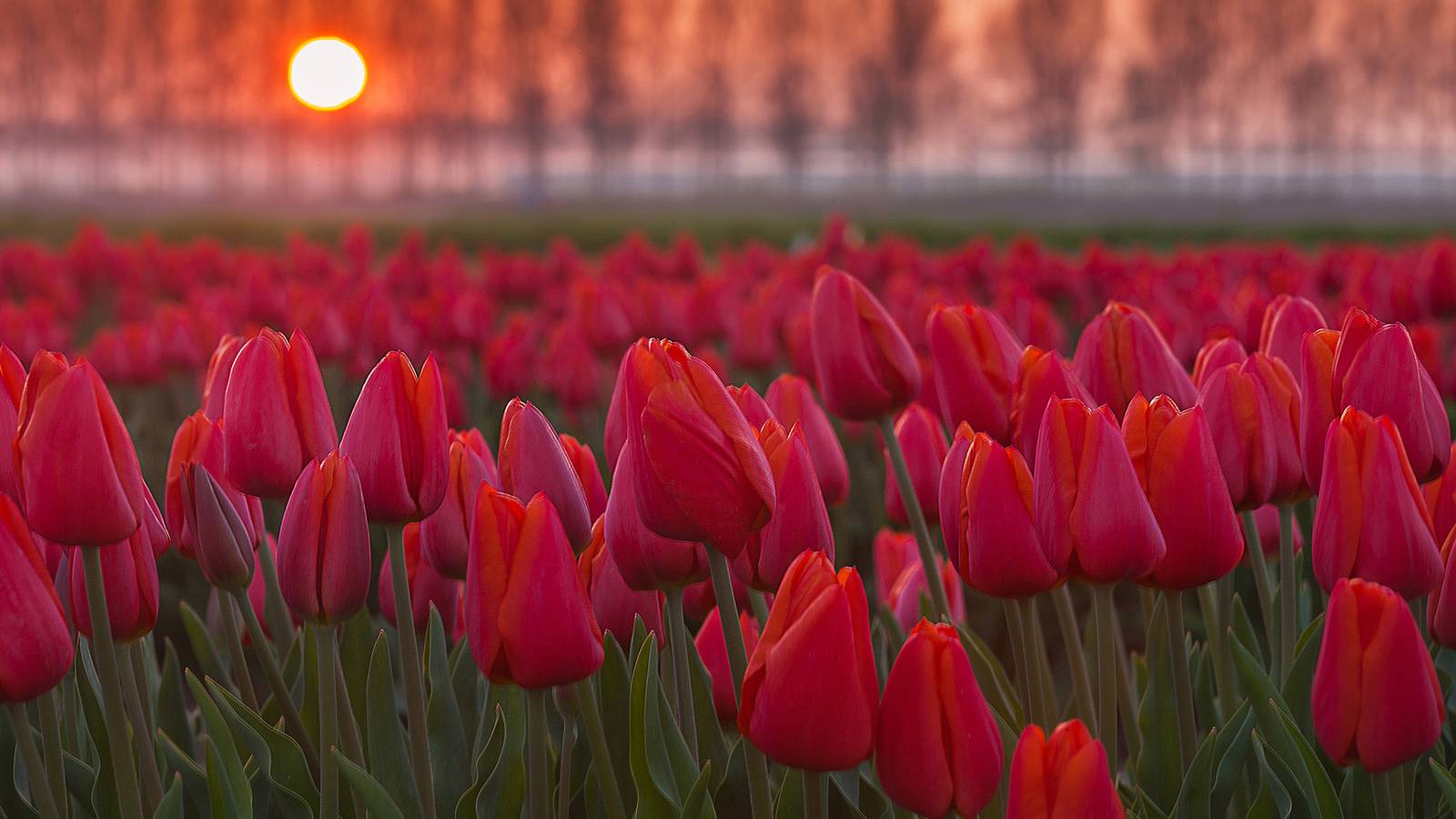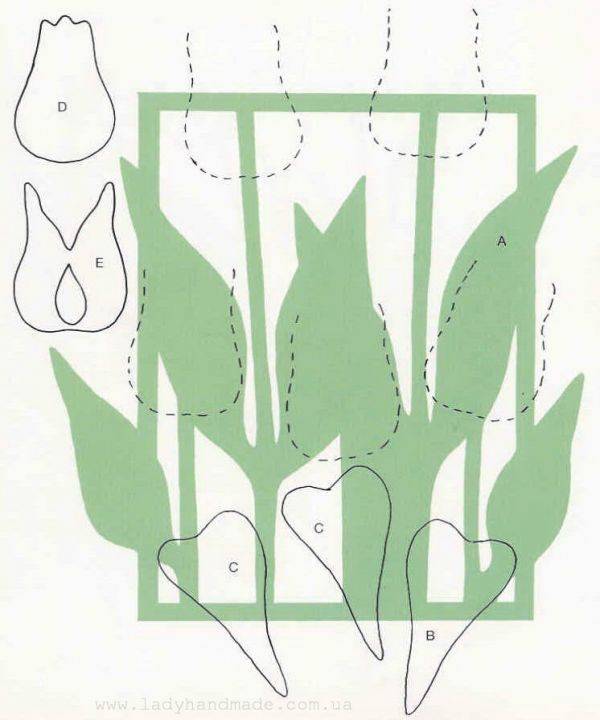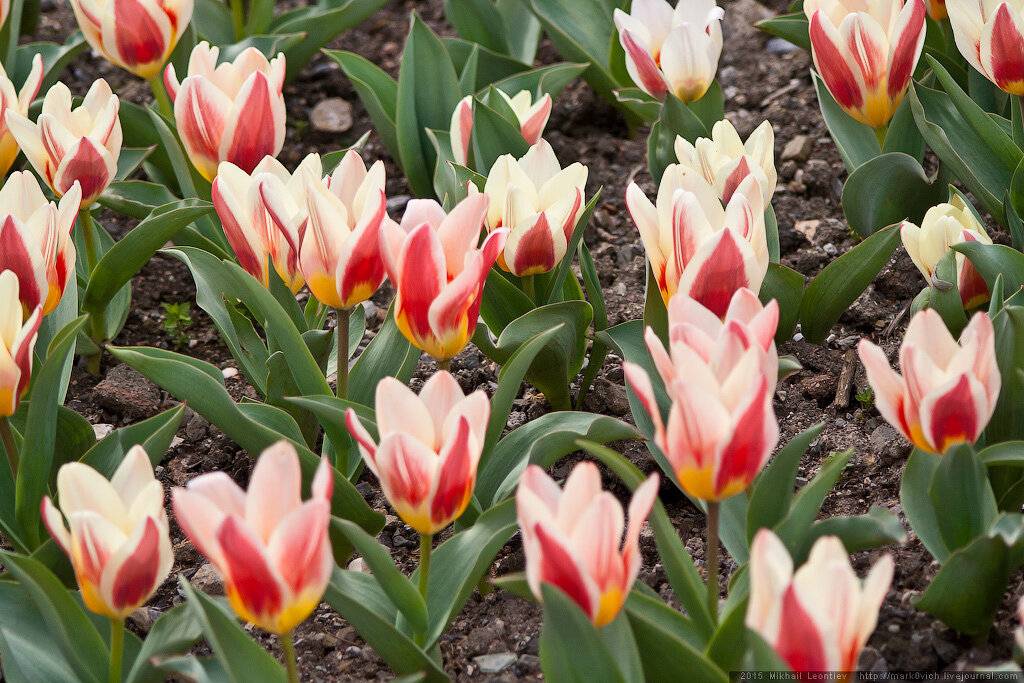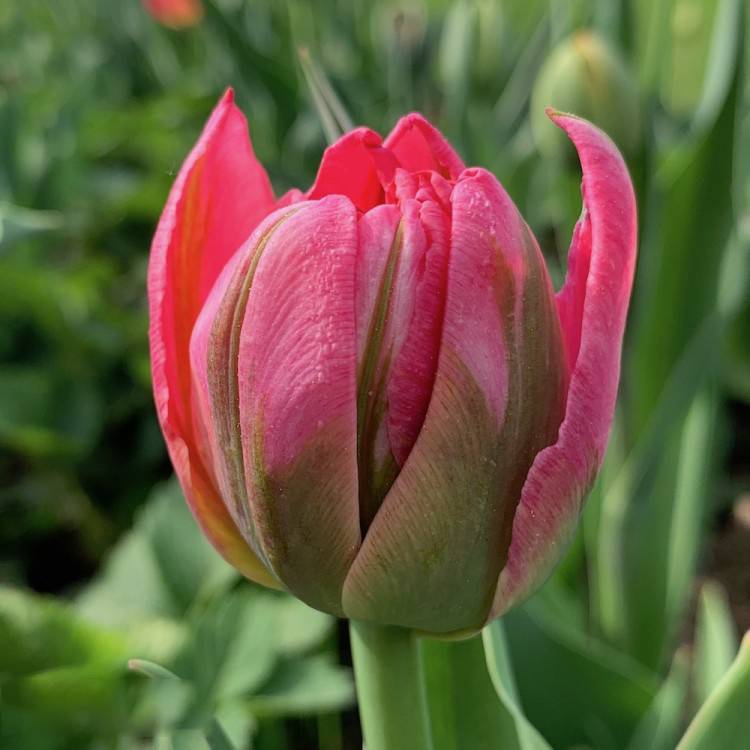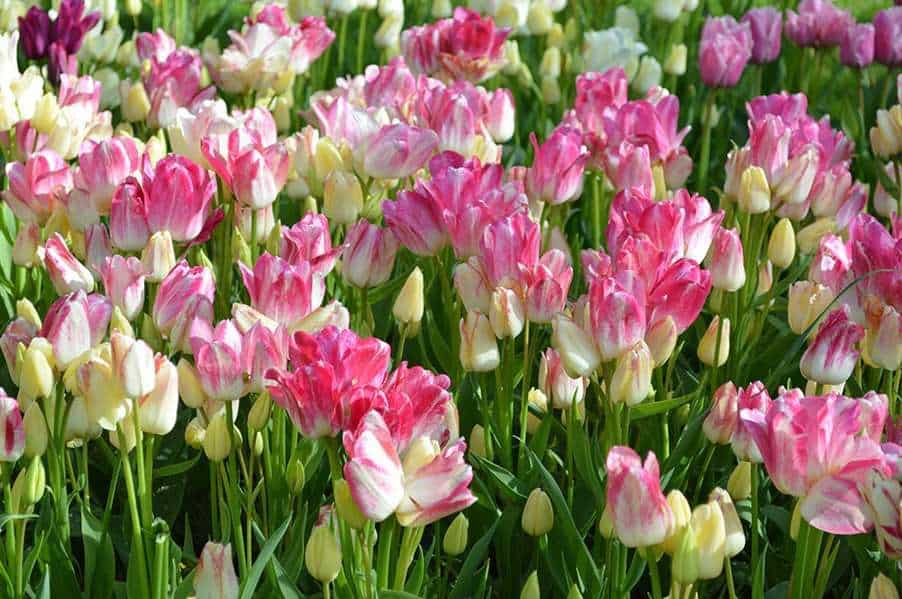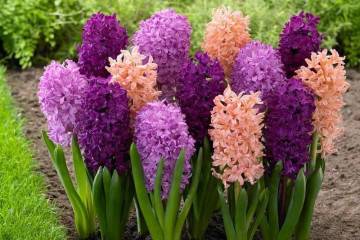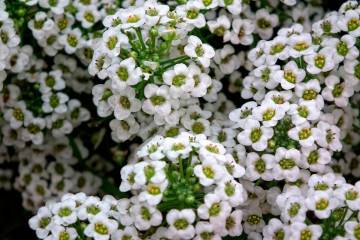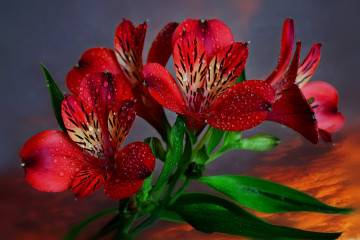Flowers tulips
Tulips are one of the favorite flowers for women and gardeners. They are easy to care for, do not require a lot of money and time. Now there are hybrids that can be grown in Russia, and not brought from Western European countries.
Flowers tulips
The original tulip varieties are representatives of the lily family, which grow mainly in regions where the harsh continental climate prevails.
What tulips look like
Hybrids bred for planting in colder and wetter regions have almost no external differences. They were bred in the 11-12 centuries in Persia. The name comes from the word "turban", because the shape of the flower is very similar to the famous headdress. The flowers of tulips are very bright and pleasant, which always remind of the spring-summer mood.
Where are found in nature
In nature, you can find tulips and daffodils in the hottest countries of Europe: Turkey, Holland, Portugal, Spain, France and other countries. Typically, tulip fields are located in the Mediterranean, Western Siberia, the Caucasus and Central Asia. In some steppes in the Urals and Central Russia, you can find wild plants in the steppes and fields. And purposefully see the fields. Sometimes tulips are found among private gardeners. True, without the necessary knowledge, you will not be able to enjoy the flowering of tulips in your own garden. Flowers do not take root without proper care, cultivation according to all the rules and in the regions of the far north.
When tulips bloom
These plants do not bloom for long. Basically, this is early spring. Most breeders focus their peak flowering in the early days of March, as in the Russian Federation the highest demand is observed on the eve of March 8th. Therefore, there are so many objections about how much tulips cost.
In fact, even in warm countries it is a bit early for flowering as the soil is still frozen. The largest number of tulips should bloom by April. The soil is already moist enough, but the air does not have a high uncomfortable temperature.
In April, flower varieties bloom that grow in the most southern regions. In Russia, especially in the middle lane, tulips bloom in May. There are also summer varieties that bloom in June and even July. The "low season" for these plants to bloom is autumn and winter. Some varieties need to be transplanted for wintering in the warmth (put on the table near the window), and when to dig out tulips and daffodils, you need to clarify for each specific variety in a particular region. And in the spring, it is better to feed the fruits with something.
What color are tulips
Gardeners are used to dividing colors into traditional ones, which nature presented to us, and exotic ones, which owe their unusual shades to biologists.
So, traditional tulips:
- Red and scarlet. It is customary to give as a sign of your love to your beloved or adored person.
- Pink tulips. They are given both to loved ones and as a token of gratitude and for any other reason.
- Yellow and orange. Previously, yellow tulips were brought as a gift in case of impending separation, while men could give them to their women when parting and as a hint that feelings had cooled down. Now this superstition is gone and yellow plants are given as a sign of the wish of wealth.
- White. They are also given to young girls as a symbol of forgiveness. Fans of white are very fond of white tulips.
What exotic varieties are there?
- Red-brown flowers with a yellow border. Dark colored tulips are found mainly in the Abu Hassan variety.
- Purplish white, milky pink, pale pink with different stripes.
- Delicate lilac, burgundy and fuchsia can also have stripes and spots that add exotic.
- There are even black ones with a thick fringe Black Beauty. In fact, the hue is closer to dark blue or dark purple. It is very difficult to find such tulips in the store, and they are snapped up quickly.
Varieties and types of tulips
Flowers have varieties not only in color, but also in shape, as well as in other types of flowers with which they were crossed. Holland and tulips are associated with each other, and in Holland there are indeed the most varieties of this plant.
Peony tulips
Peony have a shape similar to a peony or hyacinth: shorter petals, more luxuriant buds and an arcuate leaf shape. The bud size can be up to 10 cm, and some customers actually confuse these types of tulips with peonies. Looks good in single planting, and in bush plantings in pots and in the garden.
Terry tulips
Flowers of the subspecies "double" are suitable for the description and are very similar to peony, due to their shape, many lush petals. The size of the bud is about the size of a hand clenched into a fist. Sometimes, due to their own gravity, they lean close to the ground. These plants do not tolerate dampness and wind well. Therefore, it is better to grow terry tulips in greenhouses, providing them with the necessary amount of moisture. If they grow in open ground, then heavy rains and winds can spoil the flower and provoke its death. The early varieties reach 20-30 centimeters, and the later ones - up to 60 cm. In any case, these flowers are good for growing on the balcony and in the garden bed, you can do landscape design in this way. Duration of flowering of double and corrugated tulips is 2 weeks.
Botanical tulips
Botanical tulips can often be called dwarf tulips due to their short stature. Planted in gardens and pots in the foreground. Their shape differs from the traditional and peony ones. Botanical plants have straight leaves and are not splendid.
Unlike double tulips, they are quite resistant to cold temperature and wind, therefore, they can be planted in a garden in the country and not be afraid that the flowers will die as soon as the cool weather sets in. You do not need to store them in the apartment in the winter.
Morphological features of botanical tulips
As already mentioned, botanical tulips are very short in stature and are one of 15 types of tulips and bloom 2-3 weeks earlier. Highly weather resistant, botanical tulips come in many different shapes and colors. Such plants are less common on store shelves.
The botanical class has some distinct classes that are worth considering separately.
Botanical tulip varieties
- Little Princesses, which translates as "little princess". Their growth, as a rule, is up to 10 cm. They are unpretentious in care, they grow easily.The disadvantage is short flowering, which lasts just a few days.
- Turkestanika is an interesting variety that looks like an asterisk when opened. It blooms for up to 10 days, has a white color and a rather expressive aroma.
- Dasistemon Tarda - blooms in March and can grow up to 20 cm in height and have a bowl up to 5 cm in diameter. Has a yellow-white color.
- Pointed - got its name from the elongated sharp shape of the petals. Length - up to 30-40 cm and red-yellow (orange, golden) color of the bowl.
- Humilusk Odalisque - grow to a height of no more than 20 cm, and the place of distribution is predominantly Asia. The top of the petals has a bright crimson hue, and towards the root it turns into a green hue.
- Saxatilis - up to 20 cm in length, yellow bottom of the bowl, which is "exposed" in April-May. One of the features is that it does not multiply through seeds.
- Two-flowered, which is listed in the Red Book. It differs in that not one, but 2 or even 3 buds can grow on one peduncle.
- Forest - grows mainly in the wild and has no stability in flowering, the bud can only grow to the stem, and the bud can only be given once every few years.
- Fenna - Often bred for commercial outdoor activities. The stem length is up to 50-60 cm, and the color is fiery red. Loves light, tolerates frost, not requiring special shelter.
Technology for growing botanical tulips
Tulips are planted in early autumn to form roots by winter. In central Siberia, such a plant should be planted in the second half of September. Botanical tulip bulbs should be planted at a depth of about 3 times the bulb itself. That is, drill (dig) a small hole of 7-10 cm for a standard bulb. In case of bush planting, the distance between the bulbs should be 6-8 cm. During the first planting, the soil must be mulched, and in other seasons the plant will cope on its own.
Diseases and pests of botanical tulips
1 group of diseases. Fungal diseases affect both buds and stems - gray-brown spots appear, the flower itself bends and almost dies. To prevent the plant from “blooming” ahead of time, you need to monitor its habitat. The sooner the gardener begins to notice fungal manifestations, the more chances are to cure the plant and prevent its death.
Group 2. Viral diseases that are transmitted through plants through harmful insects, for example, aphids. As a rule, they transfer them from larger diseased flowers. Sometimes the virus occurs due to the fault of a person who is cutting with the same tool. That is, a gardener can cut a diseased flower, and then, a healthy one and infect it in this way.
Group 3. The last group of diseases is not associated with viruses, the influence of pests and fungi. The disease occurs as a result of improper cultivation. For example, if the soil was not chosen correctly, or the flowers were planted late and froze. Often, this symptom manifests itself as the absence of a symptom or petals.
Among the pests, mainly aphids and nematodes are distinguished. Botanical tulips have very good pest immunity.
Dutch tulips
Blue tulips
Blue Dutch tulips have become increasingly common on the counter in flower shops. But some still have doubts: do they have a natural color, or is it some kind of formula of sellers.
The blue color, indeed, in tulips is not from nature: breeders from the Netherlands worked on the development of blue and blue shades and they succeeded.
Purple tulips
Violet and blue are more correct to be considered the same, since by their nature they are purple, and under different lighting they look like blue or blue. This series also includes "black" flowers, which actually have a dark purple color.
Multi-flowered tulips
Multiflorous tulips are very beautiful and the demand for them is higher than for ordinary ones. Their peculiarity is that several buds grow from one stem, and their color can be mixed. For example, yellow-red or pink-yellow.
The number of flowers on one stem can be from 3 to 6. Such a bouquet will be much more magnificent in relation to the same number of flowers of the usual type. The disadvantage is that they are very picky: they need special care, compliance with all planting rules and protection from pests.
It will be difficult to grow a multi-flowered species without special agrotechnical conditions, especially in regions with a poor climate.
Jerusalem tulip
Now we are not just talking about some kind of tulip. The Jerusalem tulip is the most expensive flower in history. The peak of its popularity was in the X-XV centuries. He was brought from distant Central Asia to Holland and Austria. It was distinguished by its shape and attractive color - these are white petals with red flames in the middle. One collector planted them in his garden for everyone to see, and put mirrors in the middle of the bushes for the visual effect of doubling the number of flowers. At that time, the Jerusalem tulip became a symbol of wealth, and thanks to the fashion for this flower, its price was extremely high and increased all the time: a tulip was equivalent to a cow or even a whole house. Only wealthy people could afford it to satisfy their aesthetic pleasure.
Now many women love tulips more than roses, and special fans try to grow them on their own. And this is real, the main thing is to choose a variety that can bloom in a specific region without special needs and follow the planting rules.
